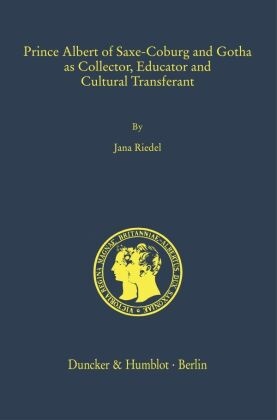Prince Albert of Saxe-Coburg and Gotha as Collector, Educator and Cultural Transferant - Dissertationsschrift
| Verlag | Duncker & Humblot |
| Auflage | 2024 |
| Seiten | 265 |
| Format | 16,6 x 2,5 x 24,0 cm |
| Gewicht | 573 g |
| Artikeltyp | Englisches Buch |
| Reihe | Prinz-Albert-Forschungen / Prince Albert Research Publications. Neue Folge 3 |
| ISBN-10 | 3428189116 |
| EAN | 9783428189113 |
| Bestell-Nr | 42818911A |
The role of Prince Albert of Saxe-Coburg and Gotha (1819-1861) as cultural transferant between Britain and the German lands has long been undervalued. This study reassesses his contribution to British life through the lens of cultural transfer theory. Examining Albert's education, collecting and working practices, it focuses on his pivotal role in the Great Exhibition of 1851. The book establishes Prince Albert as a major European cultural transferant, particularly evident in the South Kensington complex of museums known as Albertopolis.
The contribution that Prince Albert of Saxe-Coburg and Gotha (1819-1861) made as a cultural transferant between Great Britain and the German lands has long been undervalued. Historiography has tended to overlook and/or systematically underplay Albert's role in British political and cultural life, although recent research has challenged this view. This study reassesses Albert's life and work and utilises cultural transfer theory to re-appraise his contribution to the development of contemporary British society. It analyses Albert's education, his collecting and working practices and the influences that shaped his role as Prince Consort. Central to the study is Albert's involvement in the Great Exhibition of 1851 and its aftermath. This study establishes Prince Albert as a major European cultural transferant, as demonstrated especially in the South Kensington complex of museums and other cultural institutions, also known as Albertopolis.
Inhaltsverzeichnis:
Introduction
A. The Making of a Prince Consort: Prince Albert's Bildung
The early years - The teenage years - Kavaliersreisen and Grand Tours
B. Prince Albert's Collecting Practices
Early Influences on Prince Albert's Collecting Practices - Prince Albert's (and Ernst's) Early Collections - Prince Albert's (and Victoria's) Collections in Britain
C. The Basis for the Great Exhibition of 1851
The (mixed) Reception of Prince Albert in Britain - The Royal Networker - Towards the Great Exhibition of 1851
D. The Conception and Design of the Great Exhibition of 1851
Precursors of the Great Exhibition of 1851 - The Concept of the Great Exhibition - Shaping the Great Exhibition - The 'Natural Feat of Engineering' and ist Interior Design - The Organisation of the Exhibition or 'The Great Job of 1851'
E. The World Presents Itself: The Great Exhibition of 1851
The German States' Contributions, including those of Coburg and Gotha - Albert and Vi ctoria as Exhibitors at the Great Exhibition of 1851 - Hosting a World Event - London in 1851
F. Cultural Transfer and the Legacy of the Great Exhibtion of 1851
World Fairs - Albertopolis - The South Kensington Phenomenon
Epilogue
Apendix A - D
List of Illustrations, Bibliography, Index
The role of Prince Albert of Saxe-Coburg and Gotha (1819-1861) as cultural transferant between Britain and the German lands has long been undervalued. This study reassesses his contribution to British life through the lens of cultural transfer theory. Examining Albert's education, collecting and working practices, it focuses on his pivotal role in the Great Exhibition of 1851. The book establishes Prince Albert as a major European cultural transferant, particularly evident in the South Kensington complex of museums known as Albertopolis.

